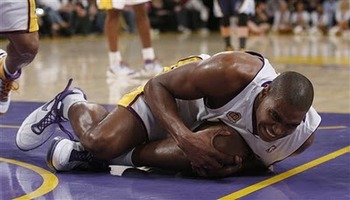Do you want to become a professional basketball player?
Nothing will crush your odds of joining the basketball elite like a history of knee pain. If you can’t run or jump with 100% effort, you won’t reach your full potential as a player. Without exceptional skills, you will go undrafted.
To join the basketball elite, you need strong knees. This article will show you how to get them.
Get Strong Knees with Just 15 Minutes of Training
If you want an NBA team owner like Steve Ballmer to pay you 7-figure salary, he won’t just look at you as a basketball player. For owners, players are huge investments that can make or break a championship team.
Start thinking like an owner today and begin seeing your body and your skills as your biggest treasures, regardless of your age. If you don’t invest time and effort into growing these assets, why would a team owner invest Millions into you?
The following exercises will keep your knees strong with just 15 minutes of daily training. This is the bare minimum investment you need to make if you want your legs to carry you on your journey to professional sports.
Self-Massage for Optimal Muscle Tension
The more time you spend training on the court or in the weight room, the better you’ll get at creating high tension in your muscles. Excessive tension and permanently tight leg muscles, however, will silently destroy your knees.
A great method to get rid of excessive tension is self-massage. Self-massage relaxes your muscles and helps the tissues in your legs stay healthy. NBA stars work with massage therapists to get rid of these soft-tissue problems. With self-massage, you can do the same. Here’s how you do it.
The two best methods to do self-massage are with a foam roller or a stick. With the foam roller, you place the roller on the ground and roll each leg and hip muscle for about a minute. Move in small strokes until you’ve rolled the whole muscle from different angles.
If you don’t have a foam roller, you can use a PVC pipe, a tennis ball, or even your hands. A great way to massage your quads, hips, and calves is by using a stick. You can use a broomstick or a curtain pole for example.
Self-massage will relax your legs, which is why it makes stretching so much more comfortable. For best results, you should massage before you stretch.
Stretches for Higher Explosiveness
Once you’re done with the self-massage, you can move on to stretching. The following stretches will help you become more explosive by increasing extensibility of your quads and calves.
Think of your leg muscles as rubber bands that contract and relax. Stretching and self-massage will make tight and knotted bands supple and strong. You’ll be able to produce more force and absorb it better. In other words, you’ll run faster and jump higher, with much less stress on your knee.
To stretch your calves, you can use special equipment such as a slanted board:
You can also place the balls of your feet on a curb and let your heels sink down. With this variation, you need to find the right-sized curb to make it work. The great advantage is that you can do it almost anywhere.
In both variations, make sure your feet are parallel and pointed forward. Don’t let your ankles roll inward, but keep pressure on the outside ridges of your feet. Relax into the stretch for about 90 seconds and feel the tension in your calves melt away.
The second stretch targets your quadriceps muscles. Excessive tightness in the quads makes you slower and places undue tension on the knee and the patellar tendon: a recipe for overuse injuries.
To do the quad stretch, place some padding in front of a wall. You can use a thick pillow or a folded blanket. Kneel down in front of the wall and place one knee directly into the corner. Now, place the other foot in front of you and push up until you’re in a lunge position like so:
Brace your abs as if you’re bracing for a punch and don’t let your hip tilt forward.
If this stretch is tough for you, your quads are tight and you can benefit greatly from doing it. Stretch each side for 90 seconds at least once per day and you’ll slowly start to see improvements.
Prevent Knee Pain and Injuries Like ACL-tears with This Exercise
Imagine you have two almost identical players on the same team. One has a 35-inch vertical leap and the other has a 30-inch vertical. Which one would you rather be?
Let’s fast-forward two years.
The 35-inch guy has to quit playing because of severe knee pain, while the other player now has a 35-inch vertical and also managed to improve every aspect of his game. He’s is already being scouted and will make it to the big leagues.
Which one would you rather be now? What do you think made the difference between success and failure?
It wasn’t genetics and it wasn’t bad luck. It wasn’t overtraining or bad footwear. It was lack of knowledge! He didn’t know how to jump without overstressing his knees. Every single jump he took damaged his knees and after more than ten thousand improper jumps, his knees were done with basketball.
To keep your knees strong and prevent injuries, you need to avoid the following two technique mistakes when jumping. The first mistake is letting your knees collapse towards the midline of your body when you jump or run. Here’s what it looks like:
Notice how the knee is no longer tracking over the toes, but has moved towards the middle of the body. This can happen quickly without you being aware of it. Have someone record your two-legged jump with a phone or a camera and play the video back in slow motion. So do your knees collapse?
The second mistake is not using the hips when jumping. You’re not using your hips if your torso stays upright and you’re knees move forward, out in front of your toes, when you jump. You don’t want this to happen:
The exercise you can use to resolve these problems is stationary jumps. To do stationary jumps, stand with your feet hip-width apart and pointed forward. Bend at the hip while keeping your shins vertical. Go as low as you can without losing the curve in your lower back.
Reverse the movement and push your hips forward, still maintaining vertical shins and good back alignment. Tense your buttocks muscles hard at the top. Do 20 to 50 repetitions.
If you can’t prevent your knees from collapsing inward, wrap an elastic band around your thighs, just above your knees and repeat the exercise. The band will provide resistance against which you will have to work, strengthening the muscles responsible for good leg alignment.
Once you can do the movement with good technique, begin doing it more explosively. Monitor your knee movement as you do this and have a friend record you if possible. Only increase the speed if alignment stays perfect.
Next, slowly begin jumping at the top of the movement and as you land, make sure to absorb the impact by hinging at the hip and not by moving your knees forward. You won’t be able to keep your shins perfectly vertical, but you’ll learn to avoid excessive forward movement.
By practicing jumping technique with stationary jumps, you dramatically decrease your risk of knee pain and injuries such as ACL-tears or meniscus tears. Instead of your knee, your muscles will be stressed when jumping.
Do You Already Have Knee Pain?
If you already have knee pain, you need to get a proper diagnosis and work with a qualified medical professional to prevent the injury from getting worse. In the meantime, you can use the self-massage exercises explained above to reduce tension on your knees, which often provides pain relief.
In jumping sports such as basketball or volleyball, the most common knee injury is patellar tendonitis, a degeneration of the patellar tendon. Unfortunately, many athletes ignore their pain until it finally forces them to drop out from sports but by then, their tendons have often been severely damaged.
To learn how you can get rid of jumping knee pain, read the article on patellar tendonitis.
How to Become a Great Basketball Player
As awesome as dunking is, it’s not the be-all end-all to your value as a basketball player and it may even get you injured. Yet, it’s what many young athletes spend time training.
Dunking is sexy, but it doesn’t win championships and it won’t get you drafted. In fact, here’s how LA Lakers director of scouting, Jesse Buss, would assess your value: “(…) physical attributes, skill level, instincts, and character are the basic principles of what I’m looking for in a player.”
Scouts don’t care if you can dunk. They do care about things like the mechanics of your shot, your 3-point range, how well you catch and shoot or shoot off the dribble, as well as your lay-up.
They’ll also look at how well you maintain control of the ball, even when dribbling under pressure. Here are some other questions scouts will ask themselves when judging your value as a player:
Do you still see the court when dribbling? How good is your passing ability? How good is your defense on and off the ball? Do you close out? How fast is your help defense? Do you anticipate rebounds well and box out consistently? Can you keep the rebound secure?
Lastly, how coachable are you? How well do you accept criticism? Can you focus even late in the game? Do you keep your team’s spirit up? How good is your work ethic?
If you merely focus on increasing your vertical leap, you will be injured eventually and won’t be able to spend as much time training. Your skill development will suffer and you’ll be one of the Millions of undrafted guys that can dunk.
The irony is that you can improve most of the skills scouts are looking for without any risk of overworking your knees. To get started, ask your coach for an honest assessment of your strengths and weaknesses.
Next, work on improving your greatest weaknesses until your coach considers them at least average. This will take several months, but it’s an investment into your future.
Once your coach no longer considers any part of your skill set below average, you can begin making one part of your game truly outstanding. This is what scouts will remember when think of you. Pick this skill based on your individual preferences, your height, and the general development in elite basketball.
If you’re small, your great skill could a fast and reliable three-point shot like Stephen Curry. If you’re tall, your great skill could be post moves that make you impossibly tough to defend like Tim Duncan. Ultimately, it’s up to you.
Work to become truly outstanding by having laser-like focus in your practice. Don’t just go through the motions. Practice every move perfectly and eventually, you can do it perfectly every time.
Share this article with your teammates to help them keep their knees strong as well.
About the Author: Martin Koban
Martin Koban is an athlete, internationally published author, and independent researcher. He writes about knee pain and self-treatment for over 50,000 monthly readers on his website Fix-Knee-Pain.com

